Full Text Searchable PDF User Manual
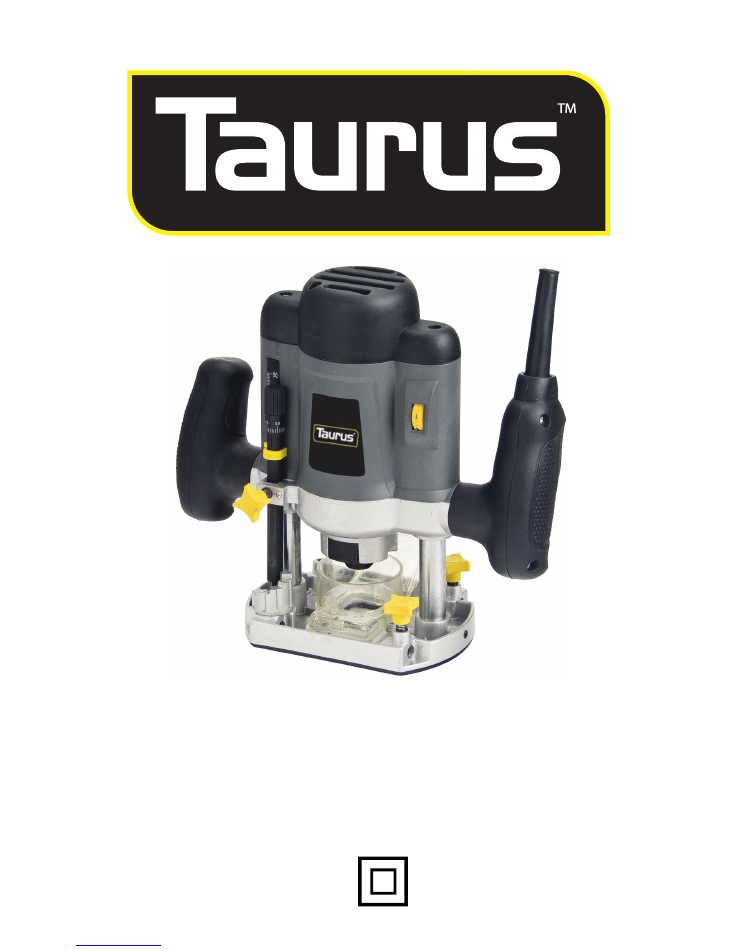
USER MANUAL
1200W ROUTER
MODEL NO.: RT1254

2
WARRANTY & SERVICE
AFTER SALES SUPPORT: TEL 1300 366 144
Model:
RT1254
Description:
1200W Router
Warranty Period:
12 Month Warranty
What your 1 Year Warranty means:
Great care has gone into the manufacture of this product and it should therefore
provide you with years of good service when used properly. In the event of
product failure within its intended use over the course of the
first
1year after the
date of purchase, we will remedy the problem as quickly as possible once it has
been brought to our attention. In the unlikely event of such an occurrence, or if
you require any information about the product please contact us via our after
sales support services, details of which can be found in this manual and on the
product itself.
Please
fill
in the Warranty
Certificate
provided and store in a safe place
along with your proof of purchase. This will be required should you need to
return the tool for service or warranty claim.

3
CONTENTS:
Warranty & Service
page 2
Introduction
page 3
Package Contents
page 4
Specifications
page 4
General Safety Information
page 5
Additional Safety Instructions
page 6
Getting to Know Your Router
page 8
Assembly
page 9
Operating Instructions
page 10
Trouble Shooting
page 13
Maintenance
page 13
Explanation of Symbols
page 14
INTRODUCTION
Congratulations on choosing to buy this TAURUS product. All products brought
to you by TAURUS are manufactured to the highest standards of performance
and safety, and, as part of our philosophy of customer service and satisfaction,
are backed by our comprehensive 1 Year Warranty.
We hope you will enjoy using your purchase for many years to come.
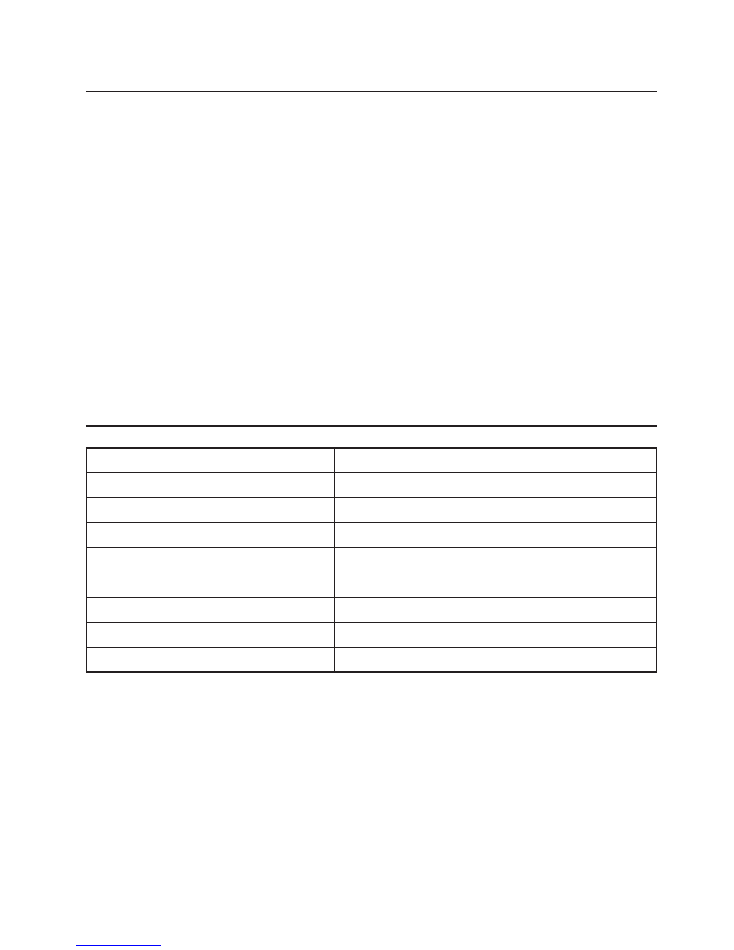
4
PACKAGE CONTENTS
Router machine, 1PC
Rods, 2PCs
Collets (1X 1/4”, 1X5/16”), Total 2PCs
Pivot Rod Trammel, 1PC
15mm template follower, 1PC Spanner, 1PC
Parallel Guide Fence, 1PC
Dust Extraction Port, 1PC (already
fixed
on main machine)
Instruction Manual, 1PC
Warranty Stickers, 2PCs
Warranty
certificate,
1PC
SPECIFICATIONS
Rated Input:
230-240V ~ 50Hz, 1200W
Collet size:
1/4” and 5/16”
No Load Speed:
11,500~30,000rpm
Cutting Capacity:
dia. 30mm
Plunge Stroke:
0~38mm with Dust Extraction
0~50mm without Dust Extraction
Sound Pressure Level
86dB(A)
Sound Pressure Level
97dB(A)
Vibration Level
3.6m/S
2
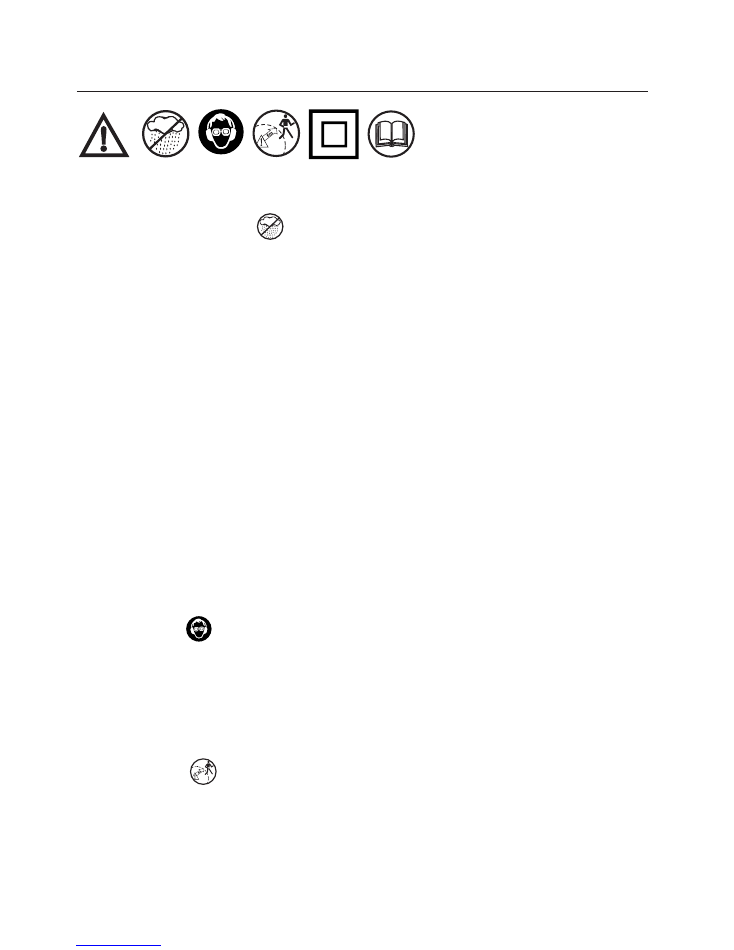
5
GENERAL SAFETY INSTRUCTIONS
When using electric tools basic safety precautions should always be followed to reduce the risk of fire,
electric shock and personal injury. Read all these instructions before attempting to use the machine.
1.
Consider the environment.
Do not work in the rain. Do not work in damp or wet conditions. Do not use without adequate
light. Do not use near flammable or hazardous materials.
2.
Keep children away.
This tool is not intended for use by young children or infirm persons without supervision. Young
children must be supervised to ensure that they do not play with this tool.
This router is not intended
for use by persons (including children) with reduced physical, sensory or mental capabilities, or lack
of experience and knowledge, unless they have been given supervision or instruction concerning
use of the router by a person responsible for their safety. Children must be supervised to ensure
that they do not play with the router.
3.
Don’t force the tool.
Do not put undue strain or force on this equipment. Do not operate any tool for extended periods
continuously, allow tool to cool. Operate only as intended.
4.
Dress properly.
Always wear suitable clothing. Do not wear loose clothing. Wear suitable footwear and keep long
hair away from moving parts.
5.
Safety glasses.
To avoid the risk of eye damage from flying material always wear suitable safety glasses.
6.
Ear protection.
To avoid the risk of hearing loss, always use a suitable hearing protection device, when operating
noisy power tools or working in a noisy environment.
7.
Lung protection.
To avoid the risk of damaging your lungs from inhaling dust or fumes always use a suitable dust
mask when working in a dust filled environment.
8.
Personal injury.
Keep hands and other body parts away from moving parts when operating. Keep other people
away from the work area to avoid personal injury through flying objects.
9.
Protect the cord.
Never carry the equipment by the cord. Do not pull the cord to disconnect from the supply. Keep

6
cord away from any sharp objects or heat source.
10.
Damaged or dropped.
Always inspect your table and supply cord before use. Do not use this equipment if it has been
damaged, dropped, left outdoors or dropped in water. Return it to an authorized service dealer
for examination and repair.
11.
Store in a safe place
Always disconnect from power supply when not in use. When not in use store your table and all
its accessories and instruction manual in a safe and dry place.
12 Store in a safe place
Have any power tool serviced by a qualified repair person using only identical replacement parts.
This will ensure that the safety of the power tool is maintained.
ADDITIONAL SAFETY INSTRUCTIONS
WARNING!
Read all instructions Failure to follow all instructions listed below may result in
electric shock, fire and/or serious injury. The term “power tool” in all of the warnings listed below
refers to your mains-operated (corded) power tool.
1)
Work area
a)
Keep work area clean and well lit
.
Cluttered and dark areas invite accidents.
b)
Do not operate power tools in explosive atmospheres, such as in the presence of flammable
liquids, gases or dust.
Power tools create sparks which may ignite the dust or fumes.
c)
Keep children and bystanders away while operating a power tool.
Distractions can cause you
to lose control.
2)
Electrical safety
a)
Power ool plugs must match the outlet. Never modify the plug in any way. Do not use any
adapter plugs with earthed (grounded) power tools.
Unmodified plugs and matching outlets
will reduce risk of electric shock.
b)
Avoid body contact with earthed or grounded surfaces such as pipes, radiators, ranges and
refrigerators.
There is an increased risk of electric shock if your body is earthed or grounded.
c)
Do not expose power tools to rain or wet conditions.
Water entering a power tool will increase
the risk of electric shock.
d)
Do not abuse the cord. Never use the cord for carrying, pulling or unplugging the power
tool. Keep cord away from heat, oil, sharp edges or moving parts.
Damaged or entangled
cords increase the risk of electric shock.
e)
When operating a power tool outdoors, use an extension cord suitable for outdoor use.
Use
of a cord suitable for outdoor use reduces the risk of electric shock.
3)
Personal safety
a)
Stay alert, watch what you are doing and use common sense when operating a power tool. Do

7
not use a power tool while you are tired or under the influence of drugs, alcohol or medication.
A moment of inattention while operating power tools may result in serious personal injury.
b)
Use safety equipment. Always wear eye protection.
Safety equipment such as dust mask,
non-skid safety shoes, hard hat, or hearing protection used for appropriate conditions will reduce
personal injuries.
c)
Avoid accidental starting. Ensure the switch is in the off-position before plugging in.
Carrying power tools with your finger on the switch or plugging in power
tools that have the
switch on invites accidents.
d)
Remove any adjusting key or wrench before turning the power tool on.
A wrench or a key left
attached to
a rotating part of the power tool may result in personal injury.
e)
Do not overreach. Keep proper footing and balance at all times.
This enables better control of
the power tool in unexpected situations.
f)
Dress properly. Do not wear loose clothing or jewellery. Keep your hair, clothing and gloves
away from moving parts.
Loose clothes, jewellery or long hair can be caught in moving parts.
g)
If devices are provided for the connection of dust extraction and collection facilities, ensure
these are connected and properly used.
Use of these devices can reduce dust related hazards
.
4)
Power tool use and care
a)
Do not force the power tool. Use the correct power tool for your application.
The correct
power tool will do the job better and safer at the rate for which it was designed.
b)
Do not use the power tool if the switch does not turn it on and off.
Any power tool that
cannot be controlled with the switch is dangerous and must be repaired.
c)
Disconnect the plug from the power source and/or the battery pack from the power tool
before making
any adjustments, changing accessories, or storing power tools.
Such
preventive safety measures reduce the risk of starting the power tool accidentally.
d)
Store idle power tools out of the reach of children and do not allow persons unfamiliar with
the power tool or these instructions to operate the power tool.
Power tools are dangerous in
the hands of untrained users.
e)
Maintain power tools. Check for misalignment or binding of moving parts, breakage of parts
and any other condition that may affect the power tools operation. If damaged, have the
power tool repaired before use.
Many accidents are caused by poorly maintained power tools.
f)
Keep cutting tools sharp and clean.
Properly maintained cutting tools with sharp cutting edges
are less likely to bind and are easier to control.
g)
Use the power tool, accessories and tool bits etc. in accordance with these instructions
and in the manner intended for the particular type of power tool, taking into account the
working conditions and the work to be performed.
Use of the power tool for operations
different from those intended could result in a hazardous situation.
5)
Service
a)
Have your power tool serviced by a qualified repair person using only identical replacement
parts.
This will ensure that the safety of the power tool is maintained.
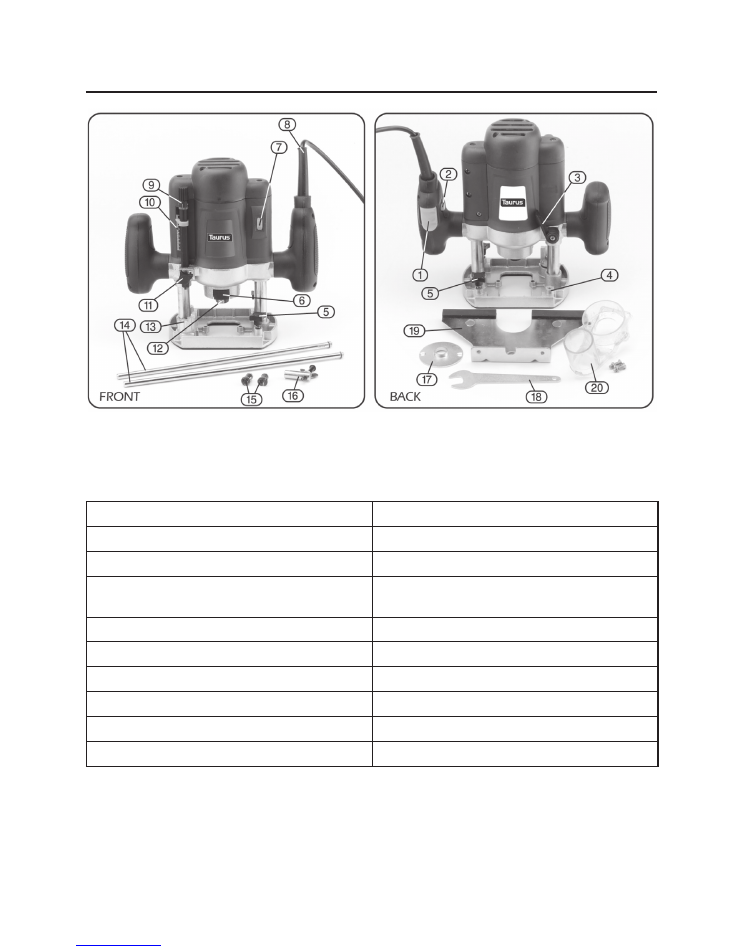
8
GETTING TO KNOW YOUR ROUTER
1. ON/OFF trigger switch
11. Height adjustment lock
2. Trigger safety button
12. Collet nut
3. Plunge lock level
13. Turret
4. Additional rod locking point (used in
conjunction with 16)
14. Rods
5. Rod locking poin
15. Collets
6. Spindle lock button
16. Pivot rod trammel
7. Variable speed dial
17. 16-18mm template follower
8. Cable sleeve
18. Spanner
9. Fine height adjustment control
19. Parallel guide fence
10. Height adjustment scale
20. Dust extraction port (fixed on machine)
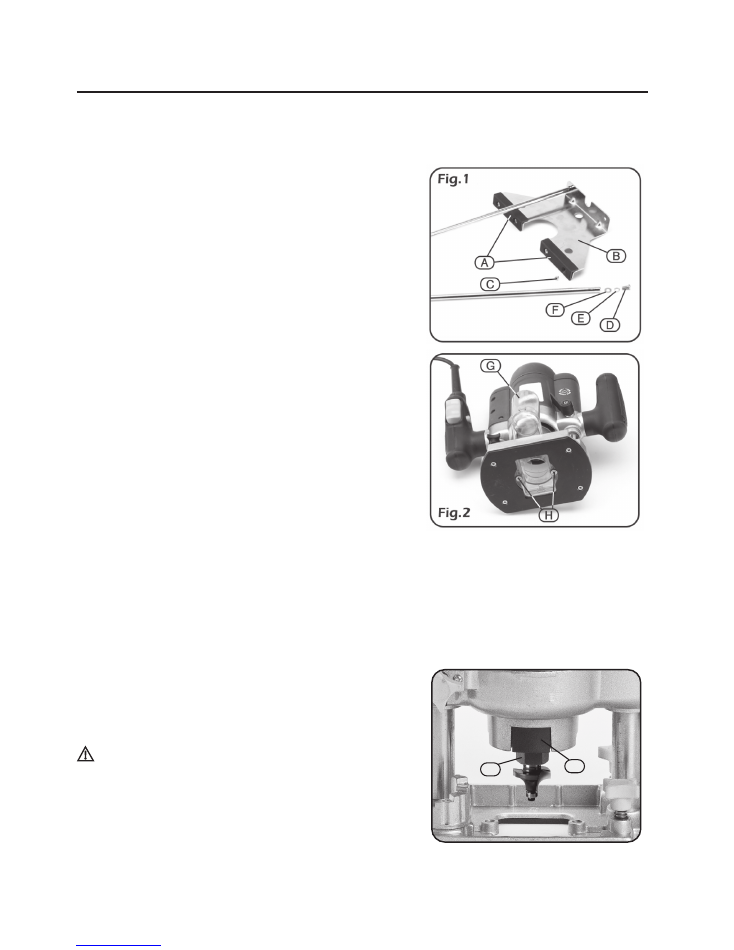
9
ASSEMBLY
Note:
Remove the plug from the socket before carrying out adjustment, servicing or maintenance.
PARALLEL GUIDE FENCE (Fig. 1)
Attach the two face plates (a) to the parallel guide fence (B)
with the four machine screws (C) supplied. Insert screw
(D) through spring washer (E) and flat washer (F). Secure the
rods onto the guide fence (B) with the screw assembly.
DUST EXTRACTION PORT (Fig. 2)
The majority of operations will require the dust extraction to
be fitted, however some operations will be impossible with
the port fitted. These require appropriate safety equipment
to be worn. Fit the dust extraction port (G) into the recess.
Pass the two machine screws (H) up through the base and
into the nuts in the port. Secure the port without damaging
the plastic parts by over tightening the machine screws.
NOTE:
With the dust extraction port fitted, the plunger
stroke is reduced to 38mm.
DUST EXTRACTION:
Inhalation of dust particles can be detrimental to health.
The dust outlet must be connected with a dust extraction
machine.
NOTE:
Due to the outlet diameter, a size adaptation may be necessary. All wood dust (including
dust form composites like chipboards and fibre boards etc.) is hazardous to health; it can affect the
nose, the respiratory system and the skin. For example MDF (medium density fiberboard) which
contains formaldehyde is a known carcinogen. In addition to the above measures a correctly fitted
dust mask, suitable for the activity and in accordance to the relevant standard, must be worn.
For work activities involving exposure to fine wood dust a mask should be used.
ASSEMBLY
FITTING & REPLACING ROUTER BITS (Fig. 3):
This router is designed for use with 1/4” and 5/16” shank
router bits only.
WARNING:
Use bits of the correct shank diameter
suitable for the speed of the
tool. Selection of the correct
router bit, suitable for the intended application is vital. Seek
guidance if uncertain of selection. Press the spindle lock
button (G) and unscrew the collet nut (H) using the spanner
supplied.
NOTE:
Take care not to be lose the spring behind the
collet. Choose from the collets provided, the appropriate size for the cutters shank 1/4” or 5/16”. If
H
G
Fig.3
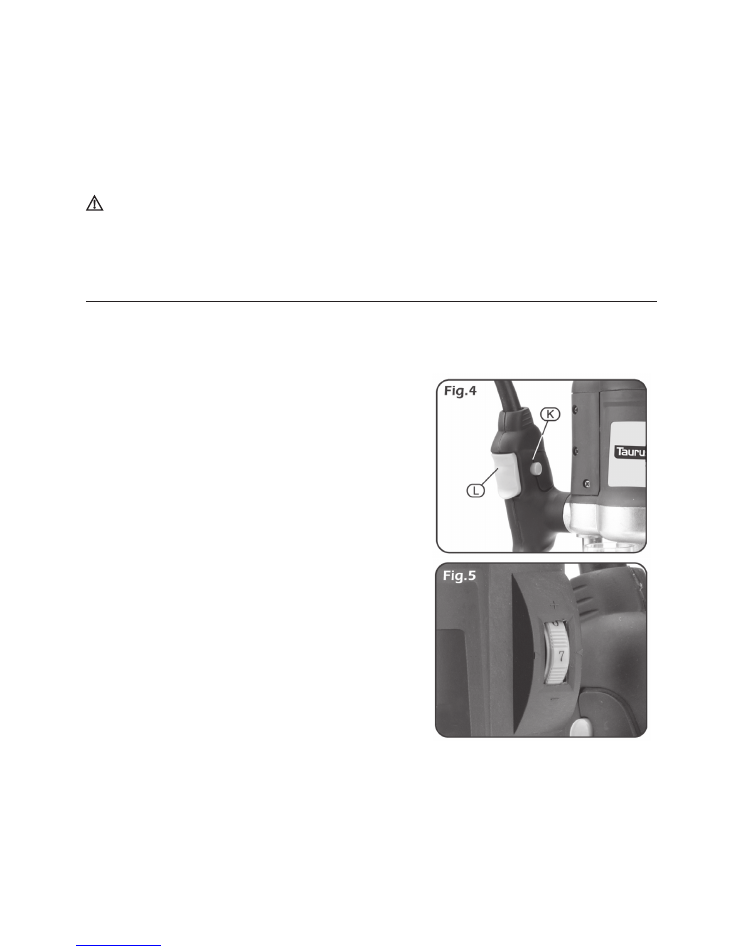
10
the size is not known insert the bit into the collet. The collet which offer a machine fit to the shank is
the correct one to use. Do not force the bit into a collet. Replace the spring and place the collet into
the spindle before loosely replacing the nut (H). Slide in the bit allowing approx. 5-10mm overhang
before tighten the collet nut (observe the router bit’s manufacturers instructions for more specific
information).
NOTE:
Ensure at least 75% of the shank is inside the collet. Do not tighten the collet with no bit
fitted as this will cause damage. Do not over tighten the collet nut.
WARNING:
Take care when handling the cutter bits as they are extremely sharp. When
cutting is complete remove the bit before cleaning and storing it in a safe place.
OPERATING INSTRUCTIONS
NOTE:
Remove the plug form the socket before carrying out adjustment, servicing or
maintenance.
TIGGER SWITCH (FIG. 4):
The router is fitted with a safety lock off switch to prevent
accidental starting. Press and hold lock button (K). Pull
trigger (L) and the router will start.
VARIABLE SPEED DIAL (Fig. 5):
The variable speed dial is marked 1 to7 and the marks
express speed from min. to max.
NOTE:
Cutting speed depends on material, cutter size,
cutting depth etc. larger router bits will require a slower
speed. For more detailed information refer to a routing/
woodworking book.
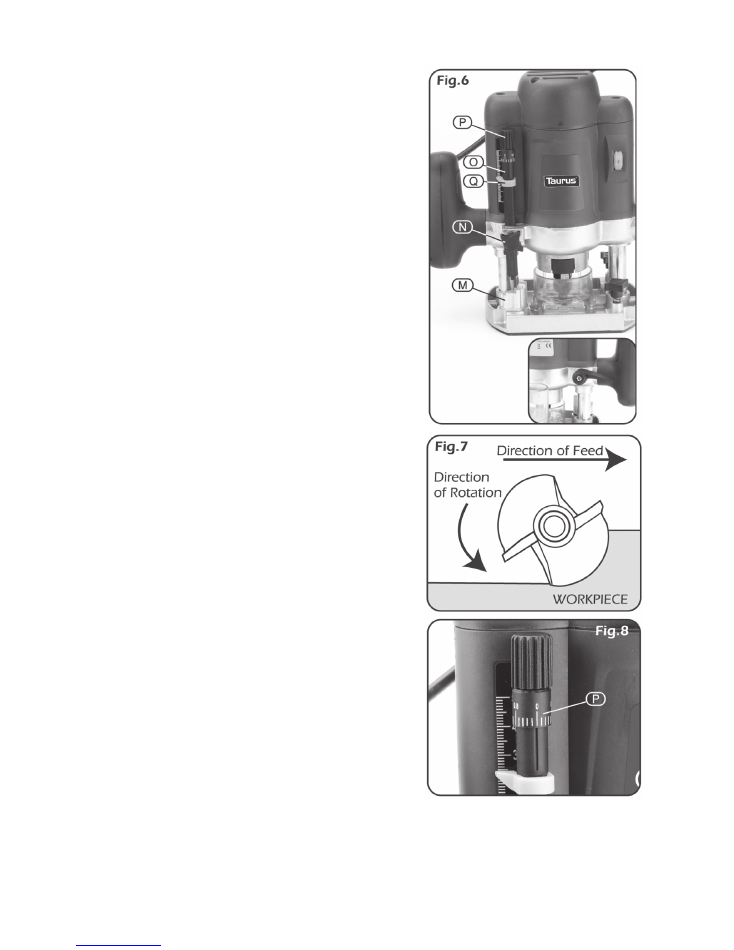
11
SETTING THE CUTTING DEPTH (Figs. 6-8)
With a suitable router bit fitted place the router on to the work
piece. Rotate the turret (M) to the lowest position. Slowly
plunge the router until the bit just touched the work piece.
Lock the router in this position with the plunge lock level.
Ensure the height adjustment lock (N) is not tight and lower
the rod (O) until it touches the turret.
If necessary turn the fine height adjustment control (P) to
align the nearest digit on the scale against the pointer (Q).
Take note of the setting before raising the rod upward
to set the plunge depth (the difference between the two
measurements) and securely tighten the height adjustment
lock (N). E.G. scale reads 23. After adjustment reads 33, the
plunge depth will be 10mm. Release the plunge lock level
and raise the router back to full height. Rotate the turret
round several positions and the router is set up ready to
begin work.
When beginning to cut, plunge the cutter slowly to the first
depth and proceed with the cut. Take a second pass at
the next step down on the turret and continue until the full
depth is achieved.
Regulate the depth of the cut and speed of feed to ensure no
strain is put on to the cutter or motor, however if the speed is
too slow burn marks may appear on the work piece.
NOTE:
The direction of rotation is marked on the metal
casting above the spindle stop mechanism. Traveling along
a work piece in the wrong direction will cause the bit to pull
and bounce, leading to a poor finish and possible damage.
If, after the full depth has been routed, further material
removal is necessary lock the router in the plunge position.
Rotate the fine height adjustment control (P). Turning the
fine adjustment (P) anti-clockwise will increase the plunge
depth. One complete turn is equivalent to 1mm plunge
depth. When set take another pass along the cut.
NOTE:
Remove the plug from the socket before carrying
out adjustment, servicing or maintenance.
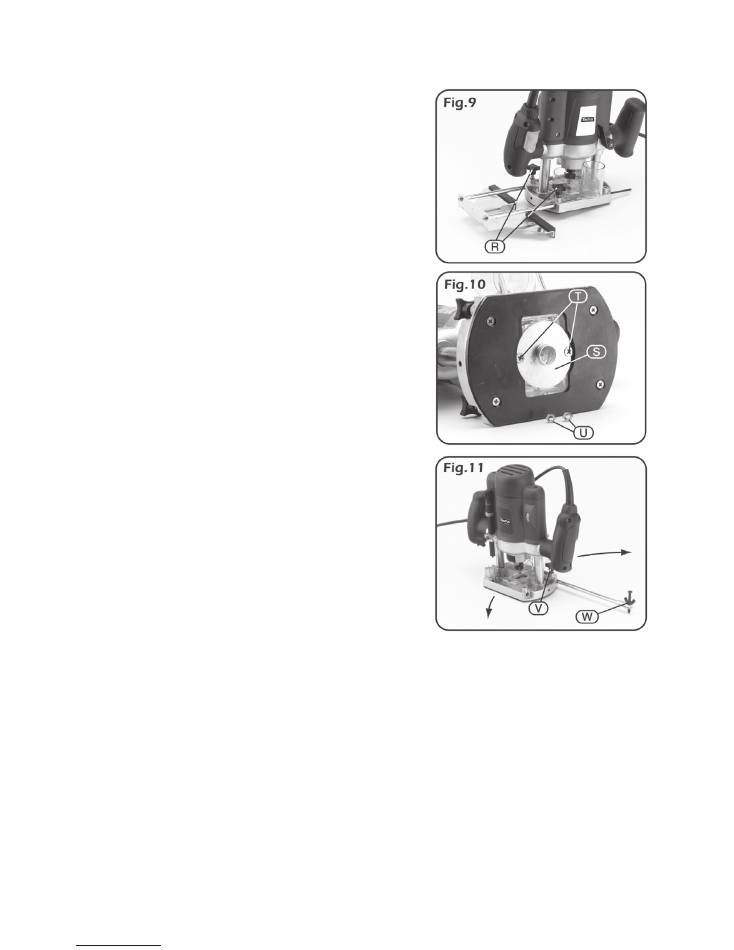
12
PARALLEL GUIDE ROUTING (Fig.9)
Ensure the edge along which the guide is going to travel is
smooth and true as any inconsistencies will translate into
the cut.
Pass the parallel guide rods through the four pointes in the
router’s base and secure in place with lock knobs ®. When
using the parallel guide an even pressure should be applied
to each face except on a leading/trailing edge of a work
piece. When leading on to a work piece apply the pressure
to the forward face until both faces are on. When trailing off
a work piece apply the pressure to the rear face until the cut
is complete.
16mm INNER-18mm OUTER DIAMETER
TEMPLATE FOLLOWER (Fig. 10)
For detailed information on templates refer to a routing/
woodworking book.
Lay the template follower (S) into the recess. Ensure the
template follower faces downward and secure with the two
countersunk screws (T)
NOTE:
For operations using the template follower without
the dust extraction port fitted use the two 8mm nuts (U).
PIVOT ROD TRAMMEL (Fig.11)
Secure one of the parallel guide rods into the rear channel.
Remove the rod locking knob from the front channel and
secure it into the additional rod locking point. Loosen the
wing nut and slide the trammel (W) on to the rod end. Adjust
the point height to suit before locking the wing nut. Adjust
the distance between the router bit and pivot point.
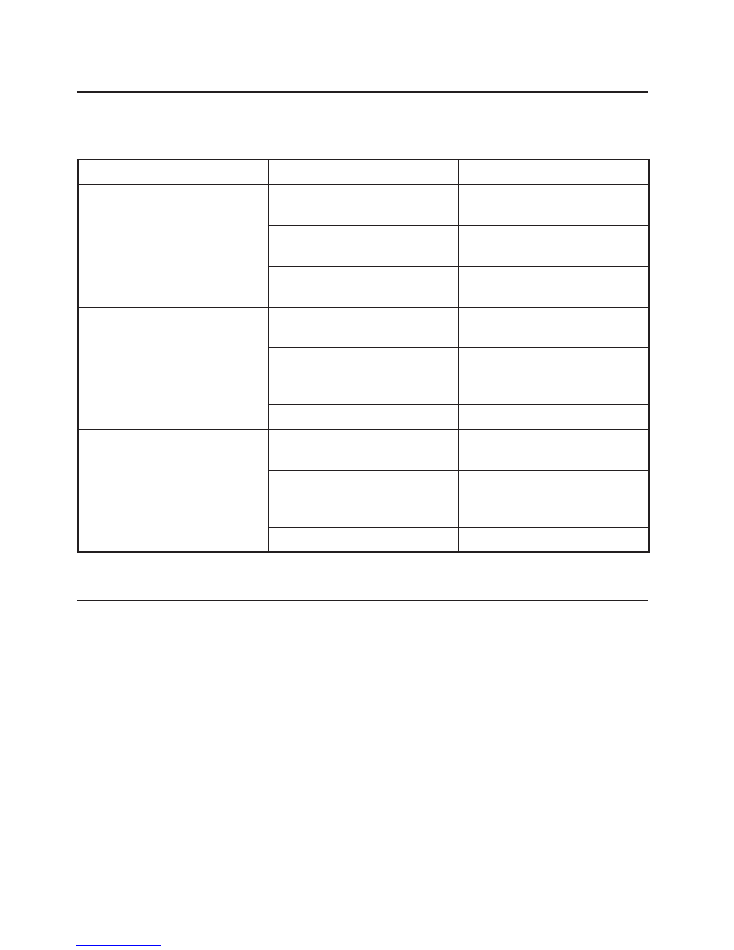
13
TROUBLE SHOOTING
NOTE: Remove the plug from the socket before carrying out adjustment, servicing or
maintenance.
PROBLEM
POSSIBLE CAUSE
REMEDY
Motor does not start
1. Fuse
1. Replace/reset time delay
fuse or circuit breaker
2. Brushes worn
2. Have brushes replaced by
authorized service agent
3. Other
3. Return to authorized service
agent
Machine vibrates
1. Router bit not suitable for
application
1. Seek guidance on bit
selection
2. Router bit blunt
2. Stop machine, when
stopped, replace with a
sharp bit
3. Incorrect direction of travel
3. Change direction of travel
Bit will not cut
1. Attempting to remove
excess material
1. Reduce plunge depth
2. Router bit blunt
2. Stop machine, when
stopped, replace with a
sharp bit
3. Incorrect direction of travel
3. Change direction of travel
MAINTENANCE
This tool requires no special maintenance.
1
. Before cleaning.
When not in use or before cleaning, always disconnect the tool from the mains supply.
2.
Cleaning guide.
Regularly clean the outside of the tool with a soft damp cloth and dry it with a dry towel. Do
not immerse adaptor or tool in water. Do not use harsh solvents to clean the plastic.
3.
Damage check.
Always inspect your tool, adaptor and cord before use. Do not use this tool if it has been
damaged, dropped, left outdoors or dropped in water. Return it to an authorised service dealer for
examination and repair.
4.
Lubrication
.
This tool requires no additional lubrication.
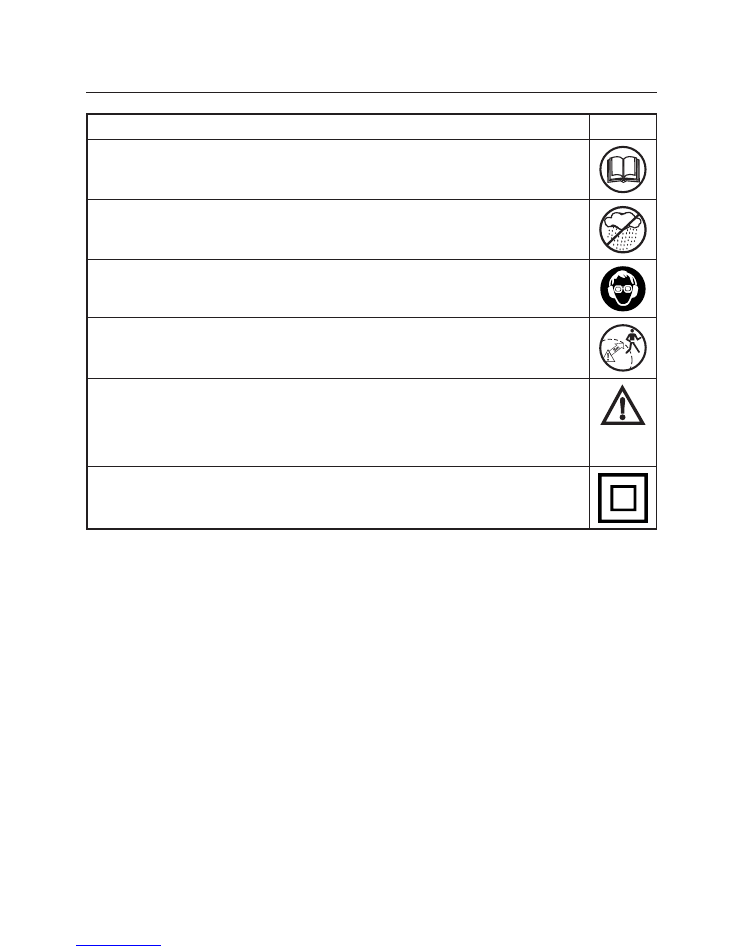
14
EXPLANATION OF SYMBOLS
Explanation
Symbols
Read operator’s manual
Do not operate unit in rain
Wear eye and ear protection
Keep bystanders at least 5m away from unit during operation.
Explanation of the safety signal words used in this manual:
“Warning” signals a hazard that may cause serious injury or death if the
recommended precautions are not followed.
“Caution” signals a hazard that may cause minor or moderate injury if the
recommended precautions are not followed.
Double insulated


16